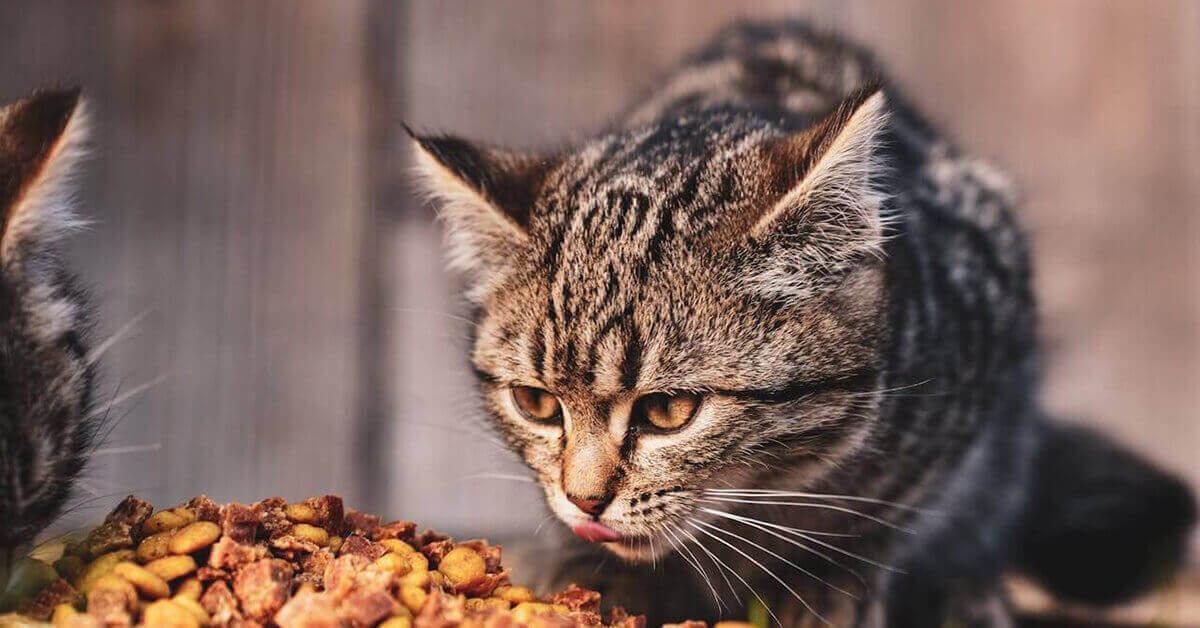3 Types of Cat Food You Should Feed Your Cat
Taking care of our furry baby’s food is one of the most fundamental aspects of cat care. With so many options out there, many purr-ents struggle to find the best suited type of cat food for their loved ones.
Because of this, we’ve decided to help out and identify the 3 most common types of food you should feed your cat.
We’re talking about dry food, wet food, and raw food, and we’ll dive into each specifically.
So, let’s get started:
3 Types of Cat Food
We’re dividing cat food into these three categories: dry, wet, and raw. Each of these three have their own unique benefits and their own drawbacks.
- Dry Cat Food
- Wet Cat Food
- Raw Cat Food
Learning of these differences can help you better understand these types and help you pick the best choice for your cat’s health, well being, and happiness.
Read on to find out the details for each of these three.
1. Dry Food
Dry food is often referred to as kibble and has quite a lot of benefits. Namely, it is convenient to buy, lay out for your cat, and it is easy to store. This type of cat food also has a longer shelf life compared to wet food.
Additionally, it is way less messier to deal with dry food as opposed to wet food, and it is much more cost-effective.
Pros
Cons
The biggest benefit of dry cat food your furry baby will have is the impact on dental health. Dry food’s crunchy texture helps reduce tartar buildup and plaque on your cat’s teeth.
That said, this type of cat food has its own drawbacks as well. It contains less moisture than wet or raw food, and this is something you need to pay attention to. Your cat’s hydration is incredibly important, so if you decide to feed your kitty with dry food only, make sure to also leave out bowls of water around for them to satiate their thirst.
If your cat doesn’t drink enough water, it can lead to issues like urinary tract problems or kidney disease.
Therefore, it is vital to make sure that your cat has constant access to fresh water. Our Kiki, for example, has a water fountain filled with water on a daily basis, and two to three water bowls placed in different rooms of our apartment. She drinks all the time from each of those water placements, and we make sure to monitor her water consumption.
2. Wet Food
Wet food comes in cans or pouches and, just like dry food, has its own set of benefits and drawbacks.
One of the main benefits of wet cat food is the high moisture content, which helps keep cats hydrated. This is immensely important, especially for cats with urinary tract issues or those that do not drink as much water on their own.
Pros
Cons
Moreover, wet food may be tastier for some cats, so it is a very good choice for picky eaters too.
On the other end of the spectrum, though, wet food is more expensive than dry food and has a shorter shelf life once opened. This means you’ll have to refrigerate this type of cat food and ensure your cat consumes it in a timely manner, requiring frequent pours in the bowl.
Additionally, it doesn’t provide the same dental benefits as dry food and it is quite a lot messier to store and serve.
What’s more, this it may contain a lot more taurine and fat, making it a bad choice for some cats. To provide an example, we gave Kiki quite a lot of wet food in the past only for her to become much more aggressive, bulkier, fatter, and with a greasy coat.
Once we stopped giving her wet food, her body became leaner, healthier, she became more muscular, and her coat is smoother, shinier, and silkier to the touch.
3. Raw Food
Raw cat food is a good choice for those who want to mimic a natural diet for their feline friends. There’s a whole host of benefits for cats who consume raw food. This type of cat food is highly nutritious and contains natural ingredients without the fillers that are often found in commercial cat food.
Pros
Cons
Raw food is often used for cats on a diet and includes raw meat, organs, bones, and fresh vegetables. This type of diet can improve the skin’s health and coat, provide high energy levels, and improve overall health and well being.
However, there are also quite a lot of drawbacks to feeding a cat with raw food. One of the biggest concerns is the risk of bacterial contamination, which can lead to illnesses both in cats and humans. To avoid these risks, it is imperative to properly handle and prepare this type of cat food.
Additionally, raw food lacks the moisture content that is present in wet food, so just as with dry food, you’ll need to make sure your cat drinks plenty of water throughout the day.
If you choose to feed your furry baby with raw food, always aim to buy fresh, high quality ingredients, and make sure to wash your hands, surfaces, and any utensils when preparing the food.
Dry Food vs Wet Food vs Raw Food
The key aspect in choosing between these three types of food is to balance your cat’s needs with your lifestyle.
Dry food is the most convenient, but lacks hydration benefits that wet food has to offer. Wet food’s essential moisture is more appealing, while raw food offers a nutrient-rich meal that would mimic a cat’s natural diet.
Each one has its pros and cons, so it’s best to combine and vary the portions, while keeping hydration in mind.
a) Dry Food vs Wet Food
Dry food is affordable, convenient, and very easy to store, while wet food offers a much higher moisture content, though it is pricier.
That said, the difference between the two is that dry food can support dental health, while wet food is ideal for cats that need extra hydration to avoid any urinary issues.
Key Comparison
- Moisture – dry food is low in moisture, while wet food is high in moisture
- Convenience – dry food is stored well and easy, while wet food needs refrigeration after opening
- Cost – dry food is cheaper, while wet food is more expensive
- Dental Health – dry food is crunchy and helps reduce plaque, while wet food offers no dental benefits
- Taste – dry food is basic, while wet food is far more palatable
b) Dry Food vs Raw Food
Dry food is processed and requires no preparation, while raw food is fresh and rich in nutrients. Raw food also requires careful handling and storage in order to prevent contamination, while dry food is safer and much easier to store.
Key Comparison
- Nutrition – dry food may contain fillers, while raw food is rich in natural nutrients
- Preparation – dry food is ready to serve in an instant, while raw food needs prep time and safe handling
- Shelf Life – dry food can last for months, while raw food must be kept fresh or frozen
- Cost – dry food is more affordable, while raw food can be costlier
- Hydration – both types have low moisture content, so extra water hydration is needed in the diet
c) Wet Food vs Raw Food
Wet food provides high hydration and is instantly ready to serve, while raw food offers an unprocessed meal and can boost energy levels.
With that in mind, wet food is much safer and more convenient, though raw food closely matches what cats would eat outdoors.
Key Comparison
- Moisture – wet food is high in moisture content, while raw food typically has less
- Processing – wet food is processed, while raw food is natural and unprocessed
- Convenience – wet food is quick to serve, while raw food requires prep and strict hygiene
- Nutrition – wet food is more balanced, while raw food is rich in nutrients, but harder to balance out without guidance
- Safety – wet food is safer from bacteria, while raw food carries contamination risks
Nutritional Specifications to Look Out For
When you’re choosing the type of cat food you want to give your cat, it is important to understand the nutritional needs. Cats are very active and require a diet that is rich in protein, vitamins, minerals, fats, and essential amino acids.
So, to ensure your cat stays healthy and receives all the necessary nutrients they need to live a healthy life, it is essential to pay attention to the nutritional specifications.
Protein-Rich Food
Protein is an essential nutrient and plays a vital role in a cat’s diet as it maintains muscle mass, supports a healthy immune system, and promotes overall growth and development. Cats naturally require a diet that is rich in animal-based proteins, so look for food that is rich in high-quality proteins.
These proteins provide the necessary amino acids that cats can’t produce on their own, which in turn leads to ensuring their nutritional needs are met and their health remains at optimal levels.
Limited-Ingredient Diet
A limited-ingredient diet for cats focuses on simplicity by using a minimal amount of ingredients.
The goal with this type of diet is to reduce the potential for allergic reactions and sensitivities in cats. These diets feature a single source of protein and basic carbohydrates, but excludes common allergens, such as dairy, grains, and artificial additives.
They can be highly beneficial for cats with sensitive digestive systems, skin issues, or cats with food allergies or intolerances.
🐾 Feeding your furry little baby with protein-rich food or a limited-ingredient diet can go a long way to alleviate any issues, allergy symptoms, and improve overall health and well-being.
Final Remarks
Now that we’ve covered all the important aspects on the types of food available for your cat, we’re left to offer our own opinion on the question – what type of cat food should you feed your cat?
Our advice is to feed your cat with dry food only, while keeping in mind its hydration needs. You can always give wet or raw food, but make sure to do so on rare occasions, such as milestones, birthdays, or when you’ve been away from home for a few days, and you’d like to treat them with something special.
This is what works best for our loving Kiki as she adores dry food, drinks plenty of water, and doesn’t whine, complain, or ask for any other form of food, especially raw or human food.

